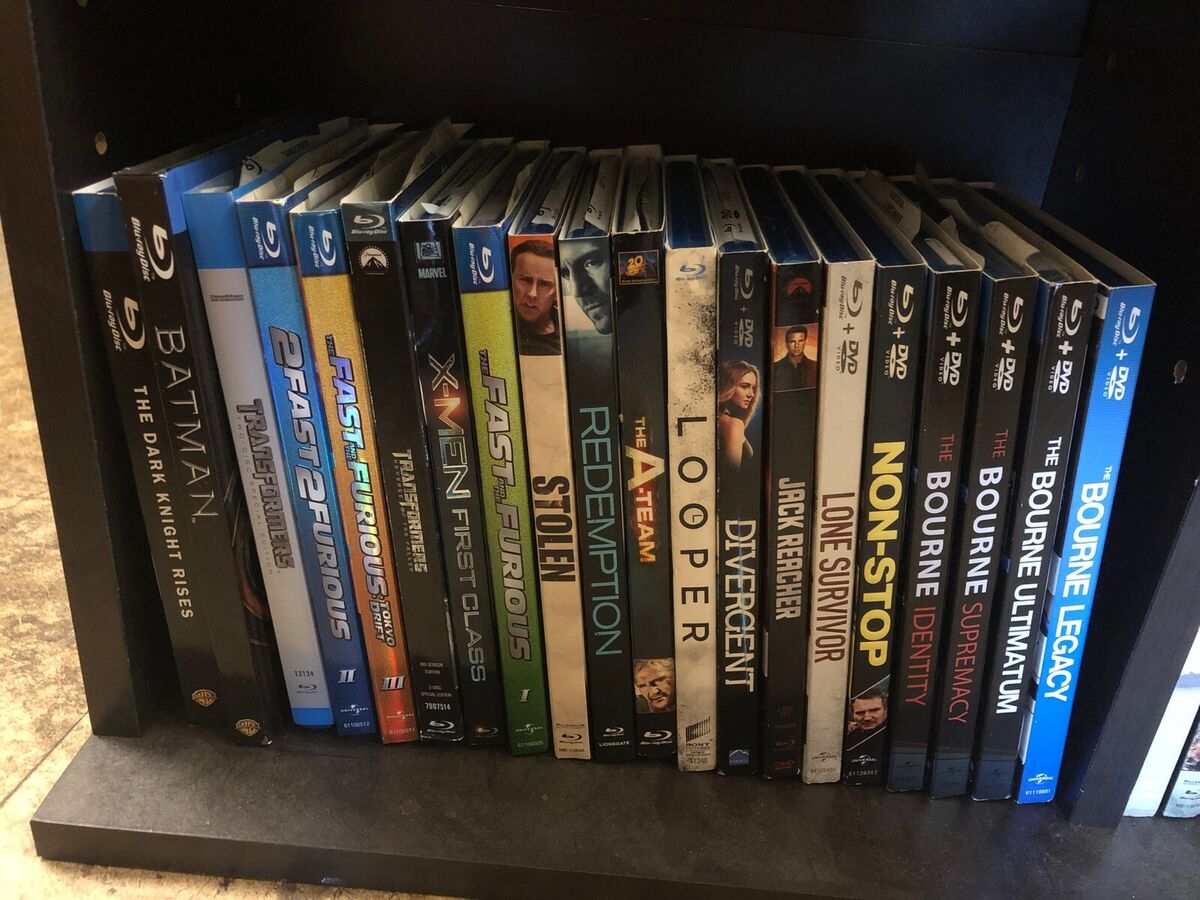

Articles
How To Store Digital Movies
Modified: January 7, 2024
Learn the best methods to store and organize your digital movie collection with these informative articles. Find expert tips and recommendations to keep your movies safe and easily accessible.
(Many of the links in this article redirect to a specific reviewed product. Your purchase of these products through affiliate links helps to generate commission for Storables.com, at no extra cost. Learn more)
Introduction
Welcome to the digital age where movie-watching has transcended the limitations of physical media and moved into the realm of digital formats. Gone are the days of bulky DVD cases and shelves filled with movies. With the advent of streaming services and digital downloads, storing and accessing your favorite movies has become easier and more convenient than ever before.
However, with the vast array of digital movie formats and storage options available today, it can be overwhelming to navigate the world of digital movie storage. That’s where we come in. In this article, we will guide you through the process of storing your digital movies, helping you choose the right storage device, organize your collection, transfer files, back up your movies, and protect them from loss or damage.
Whether you’re a cinephile with an extensive movie library or just someone who enjoys the occasional film, this article will provide you with valuable insights and tips to ensure that your digital movie collection is well-organized and easily accessible whenever you want to indulge in a movie night.
So, without further ado, let’s embark on this digital movie storage journey and discover the best practices to store and safeguard your beloved digital movies.
Key Takeaways:
- Embrace the digital movie era by understanding formats, choosing the right storage device, and organizing your collection. Safeguard your movies with backups, cloud storage, and protection measures for a seamless movie-watching experience.
- Ensure your digital movie collection’s longevity and accessibility by transferring movies to external hard drives, utilizing file naming and metadata, and exploring cloud storage options. Protect your movies from loss or damage with reliable storage devices and backup strategies.
Read more: How To Store Movies On ICloud
Understanding Digital Movie Formats
Before we dive into the world of digital movie storage, it’s important to understand the different types of digital movie formats you may encounter. Each format has its own advantages and disadvantages, and choosing the right format can greatly impact the quality and compatibility of your movies.
The most common digital movie formats include:
- MP4: MP4 is a widely used video format as it offers good compression and maintains high video quality. It is compatible with most devices and video players, making it an ideal format for storing digital movies.
- MKV: MKV (Matroska Video) is a flexible and open-source container format that supports various audio, video, and subtitle streams. It is known for its ability to store high-definition video and multiple audio tracks, making it popular among movie enthusiasts.
- AVI: AVI (Audio Video Interleave) is an older video format that offers good compatibility but can have larger file sizes. It is still used by some older devices and video players.
- MOV: MOV is a video format developed by Apple and is commonly used for storing movies on Mac computers and iOS devices. It is compatible with QuickTime Player and other Apple devices.
- WMV: WMV (Windows Media Video) is a video format developed by Microsoft. While it is not as widely used as other formats, it is compatible with Windows devices and can provide good video quality.
When choosing a digital movie format, consider factors such as device compatibility, file size, video quality, and audio support. It’s also worth mentioning that some streaming services and online stores may offer movies in their proprietary formats, such as Netflix’s streaming format or Apple’s iTunes format. Be aware of these formats and their limitations when purchasing or renting digital movies from specific platforms.
Now that we have a basic understanding of digital movie formats, let’s explore how to choose the right storage device to house your growing collection.
Choosing the Right Storage Device
When it comes to storing your digital movie collection, selecting the right storage device is crucial. There are several options available, each with its own advantages and considerations. Let’s explore some of the common storage devices and their suitability for storing digital movies.
1. External Hard Drives: External hard drives are a popular choice for storing digital movies due to their large storage capacities and portability. They can range from small pocket-sized drives to larger desktop models. Look for drives with ample storage space, fast transfer speeds, and compatibility with your computer or media player.
2. Network Attached Storage (NAS): NAS devices are like personal cloud storage solutions that connect to your home network. They offer centralized storage and allow you to access your movies from multiple devices within your home. NAS devices often come with features like RAID configurations for data redundancy and can be a good option if you have a considerable movie collection.
3. Cloud Storage: Cloud storage services like Google Drive, Dropbox, or iCloud offer convenient and scalable options for storing digital movies. You can upload your movies to the cloud and access them from any device with an internet connection. However, keep in mind that cloud storage may have limitations on storage space and may require a subscription plan for larger capacities.
4. Media Servers: Media servers, such as Plex or Kodi, transform your computer or NAS device into a centralized hub for streaming and organizing your digital movie collection. They provide a user-friendly interface, support for various file formats, and even allow remote access to your movies. Media servers are a great option if you want a dedicated platform for managing and streaming your movies.
When choosing a storage device, consider factors such as storage capacity, data transfer speeds, compatibility with your devices, and the scalability of your collection. Also, think about your usage patterns and the level of accessibility you want for your movies. For example, if you prefer streaming your movies across multiple devices, a cloud storage solution or media server might be more suitable.
Ultimately, the right storage device will depend on your specific needs and preferences. It’s always a good idea to invest in a reliable and reputable brand to ensure the longevity and security of your digital movie collection.
Now that you have chosen the storage device that suits your requirements, let’s move on to organizing your digital movie collection for easy retrieval.
Organizing Your Digital Movie Collection
Organizing your digital movie collection is essential for easy accessibility and hassle-free movie watching. With a well-organized collection, you can easily find the movie you want to watch, browse through genres, actors, or directors, and keep track of what you’ve watched and what you haven’t. Here are some tips to help you organize your digital movie collection effectively:
1. Create Folders: Start by creating folders on your storage device to categorize your movies. You can create folders based on genres (e.g., Action, Comedy, Drama), release years, or any other criteria that make sense to you. This will make it easier to locate specific movies.
2. Use Descriptive File Names: Rename your movie files using descriptive titles. Include the movie’s title, year of release, and possibly the format of the movie (e.g., 1080p, Blu-ray). This will make it easier to identify movies at a glance when browsing through your collection.
3. Add Metadata: Utilize metadata to enhance your movie organization. Many media players and library management software can automatically fetch movie metadata such as posters, plot summaries, and cast information. This not only makes your collection visually appealing but also helps in quickly identifying and organizing movies based on specific criteria.
4. Tagging and Rating: Consider using tags or ratings to further organize your movies. You can create tags based on themes (e.g., “Superhero”, “Oscar Winners”) or add personal ratings to keep track of your favorite movies. This way, you can easily filter and sort movies based on your preferences.
5. Keep a Watchlist: Maintain a separate folder or document to create a watchlist. This is especially helpful if you have a large collection and want to keep track of movies you plan to watch. Add movies to the watchlist as you come across recommendations or decide what to watch next.
6. Consider Library Management Software: If you have a substantial movie collection, consider using library management software like Plex, Emby, or Kodi. These platforms allow you to manage and organize your collection, fetch metadata automatically, create playlists, and even provide recommendations based on your viewing habits.
By implementing these strategies, you can ensure that your digital movie collection is well-organized and easily navigable. Whether you’re in the mood for a specific genre or simply want to explore new movies, having an organized collection will enhance your movie-watching experience.
Now that your digital movie collection is organized, let’s see how you can transfer your movies to an external hard drive for easy storage and access.
File Naming and Metadata
File naming and metadata play a crucial role in organizing and managing your digital movie collection. They help you identify and categorize your movies accurately, making it easier to find and enjoy your favorite films. Let’s explore some best practices for file naming and utilizing metadata:
1. Consistent File Naming: Use a consistent file naming convention for your movie files. Include the movie title, year of release, and possibly the format or resolution of the file. For example, “The Matrix (1999) 1080p.mp4”. This will ensure that your movies are easily identifiable when browsing through your collection.
2. Consider Including Additional Information: Depending on your preferences, you can include additional information in the file names. This could include the director’s name, the main actors, or even the genre of the movie. For example, “Inception (2010) [Christopher Nolan] 720p.mkv”. Adding more details can be helpful when searching for movies based on specific criteria.
3. Automated File Naming Tools: If you have a large movie collection, consider using automated file naming tools or applications. These tools can fetch movie metadata, including titles, release years, and other relevant information, and automatically rename your files accordingly. This saves you time and ensures consistent and accurate file names.
4. Utilize Movie Metadata: Movie metadata provides additional information about a film, such as the plot summary, cast and crew details, genre, and even poster artwork. Many media players and library management software can automatically fetch and display this metadata for your movies. Take advantage of these features to make your collection visually appealing and easily searchable.
5. Manually Update Metadata: In some cases, automated metadata retrieval may not provide accurate or complete information for a particular movie. In such instances, you can manually update and edit the metadata. This allows you to ensure that the movie’s details are correct and consistent with your collection.
6. Batch Update Metadata: If you have a large movie collection, updating metadata for each individual movie can be time-consuming. Look for software or tools that allow you to batch update metadata. These tools can analyze your movie files and automatically fetch metadata for multiple movies at once.
By following these file naming and metadata practices, you can create a well-organized and visually appealing digital movie collection. Whether you’re searching for a specific film or exploring movies based on particular actors or genres, accurate file names and comprehensive metadata make the process much smoother and enjoyable.
Now that you’ve organized your digital movie collection, let’s move on to the process of transferring your movies to an external hard drive for secure storage and easy access.
Consider storing digital movies on an external hard drive or cloud storage to free up space on your devices. Make sure to organize and label your files for easy access.
Read more: How To Store Movies
Transferring Digital Movies to External Hard Drive
Transferring your digital movies to an external hard drive is a practical and efficient way to store and access your collection. Whether you want to free up space on your computer or create a portable movie library, here’s a step-by-step guide to help you transfer your movies to an external hard drive:
1. Connect the External Hard Drive: Plug in your external hard drive to your computer using the provided USB cable. Ensure that the drive is properly connected and recognized by your operating system.
2. Create a Movie Folder: On the external hard drive, create a folder specifically for storing your movies. You can name it “Movies” or any other descriptive term that suits your preference.
3. Copy the Movies: Locate your digital movie files on your computer. You can use the search function or browse through your directories to find your movies. Select the movies you want to transfer and copy them to the newly created “Movies” folder on the external hard drive. You can drag and drop the files, or use the copy-paste function.
4. Monitor the Transfer Progress: Depending on the size and number of movies you’re transferring, it may take some time to complete the process. Monitor the transfer progress to ensure that all the files are successfully copied to the external hard drive. Avoid interrupting the transfer or disconnecting the hard drive until the process is complete.
5. Verify the Movie Files: After the transfer is complete, carefully verify that all the movie files have been successfully copied to the external hard drive. Double-check the file sizes and compare them to the originals on your computer to ensure that no data loss or corruption has occurred during the transfer.
6. Eject the External Hard Drive: Once you’ve confirmed that the movie files are safely transferred, eject the external hard drive from your computer. Follow the proper ejection process specified by your operating system to avoid any potential data loss or damage to the drive.
With your movies now safely stored on the external hard drive, you can easily access them whenever you want to watch a film. Simply connect the external hard drive to your computer or compatible media player, and browse through the “Movies” folder to find and enjoy your digital movie collection.
Additionally, it’s a good practice to regularly update your external hard drive with new movies or remove any duplicates or unwanted files. This helps you maintain an organized and up-to-date movie library on your external storage device.
Next, let’s explore the importance of backing up your digital movie collection to protect it from accidental loss or damage.
Backing Up Your Digital Movie Collection
Backing up your digital movie collection is a crucial step to ensure that your movies are protected from accidental loss, device failure, or data corruption. Without a proper backup strategy, you run the risk of losing your entire collection. Here are some steps to help you back up your digital movie collection:
1. Choose a Backup Solution: There are several backup solutions available, including external hard drives, network attached storage (NAS), and cloud storage. Assess your needs and budget to determine which option is best for you. Ideally, it is recommended to have multiple backup copies for added security.
2. Set Up a Regular Backup Schedule: Establish a recurring backup schedule for your digital movie collection. Depending on how frequently you add new movies to your collection, you may choose to back up your movies monthly, weekly, or even daily. Consistency is key to ensure your backup is up to date.
3. Copy Movies to the Backup Storage: If using an external hard drive or NAS, create a separate folder for your movie backups. Copy your digital movie files from your primary storage device (computer or external hard drive) to the backup storage on a regular basis. If using cloud storage, follow the service’s instructions to upload and sync your movie files.
4. Verify the Backup: After copying your movie files to the backup storage, verify that the files are successfully transferred and intact. Compare file sizes and run spot checks on a few movies to ensure the backup is accurate and complete.
5. Keep Multiple Copies: It’s recommended to have multiple backup copies of your digital movie collection. This can include having a local backup on an external hard drive or NAS, as well as a backup in the cloud. Having multiple backups reduces the risk of losing your movies in case of a hardware failure or disaster.
6. Update the Backup: As you add new movies to your collection, make sure to update your backup to include the new additions. Regularly syncing your backup storage with your primary storage keeps your backup up to date.
7. Test the Backup Restoration: Periodically test the restoration process from your backup storage. This ensures that your backup is functional and you can recover your movies if needed. Verify that you can successfully restore a few movies from the backup onto your primary storage device.
By implementing a regular backup routine and following these steps, you can safeguard your digital movie collection from potential loss or damage. Having a reliable backup ensures that you can always recover your movies and continue enjoying your collection with peace of mind.
Now that we’ve covered the importance of backing up your digital movie collection, let’s explore the option of storing your movies in cloud storage for added convenience and accessibility.
Storing Digital Movies in Cloud Storage
Cloud storage offers a convenient and accessible solution for storing your digital movie collection. By uploading your movies to the cloud, you can access them from any device with an internet connection, eliminate the need for physical storage space, and ensure the safety and security of your movies. Here are some key considerations and steps for storing your digital movies in cloud storage:
1. Choose a Cloud Storage Provider: There are numerous cloud storage providers available, such as Google Drive, Dropbox, OneDrive, and iCloud. Compare their features, storage plans, and pricing to determine which provider suits your needs and budget.
2. Create an Account: Sign up for an account with your chosen cloud storage provider. This usually requires providing your email address and creating a secure password. Some providers offer free storage plans with limited capacity, while others offer paid plans with larger storage capacities.
3. Install the Sync Application: Most cloud storage providers offer sync applications that allow you to easily upload and sync files between your devices and the cloud. Install the sync application on your computer or mobile device to enable seamless transfer of your digital movie files.
4. Organize Your Movie Files: Before uploading your movies, organize them into folders on your computer. Create separate folders for different genres, or organize them based on your preferred criteria. This will make it easier to navigate and find your movies in the cloud storage interface.
5. Upload Your Movies: Once your movies are organized, use the sync application to upload them to your cloud storage account. You can either upload entire folders or select specific movie files to be uploaded. Keep in mind that the upload process may take some time depending on the size of your movies and internet connection speed.
6. Manage Your Movies in the Cloud: After uploading your movies, you can manage them within the cloud storage interface. Some providers offer features like file previews, file sharing, and collaboration options. Explore these features and customize your movie collection based on your preferences.
7. Access Your Movies: With your movies stored in the cloud, you can access them from any device with internet access. Use the cloud storage provider’s website or mobile application to browse and stream your movies directly, or download them to your device for offline viewing.
8. Consider Security: Protect your digital movies in the cloud by enabling security measures such as two-factor authentication and strong passwords. Additionally, read the privacy and security policies of your chosen cloud storage provider to ensure your movies are stored securely.
Cloud storage offers the advantage of accessibility and convenience. However, it is important to be aware of storage limitations and consider the cost implications of larger storage capacities. Regularly review your storage usage and consider upgrading your plan if necessary.
Now that you’ve explored the option of storing your digital movies in the cloud, let’s discuss how to protect your movies from loss or damage.
Protecting Your Digital Movies from Loss or Damage
Protecting your digital movie collection from loss or damage is crucial to ensure that you can enjoy your movies for years to come. Here are some important steps you can take to safeguard your digital movies:
1. Backup Your Movies: Start by creating backups of your digital movie collection. As mentioned earlier, consider having multiple copies stored in different locations, such as external hard drives, network attached storage (NAS), or cloud storage. Having backups ensures that even if one storage device fails, you still have access to your movies.
2. Store Backup Copies Separately: If you have physical backups, such as external hard drives or NAS devices, it’s important to keep them stored in a separate location from your primary storage. This protects your collection from events like theft, fire, or other disasters that may affect a single location.
3. Use Reliable Storage Devices: Invest in high-quality and reliable storage devices for storing your digital movies. Choose well-known brands that have a good track record for durability and data integrity. This reduces the risk of data loss or hardware failure.
4. Protect Against Viruses and Malware: Use a reliable and up-to-date antivirus program to protect your devices from viruses and malware. Malicious software can cause data corruption or loss, so it’s important to have proper security measures in place to safeguard your movies.
5. Handling and Transport: When handling and transporting physical storage devices like external hard drives, make sure to do so with care. Avoid dropping or exposing them to extreme temperatures, as this can damage the hardware and compromise your data.
6. Label and Catalog Your Movies: Keep track of your movies by labeling and cataloging them. This can be done physically by attaching labels to your physical storage devices or digitally by maintaining a detailed list or database of your movies. This helps you quickly identify and locate specific movies within your collection.
7. Keep Software and Firmware Up to Date: Regularly update the software and firmware of your devices to ensure compatibility and security. Manufacturers often release updates that address potential vulnerabilities and improve the overall performance of the devices.
8. Protect Against Data Corruption: Take precautions to protect your movies against data corruption. This can include using error-checking software, avoiding sudden power loss during data transfers, and ensuring that your storage devices have proper ventilation to prevent overheating.
By implementing these measures, you can significantly reduce the risk of losing your digital movie collection and enjoy your favorite films with peace of mind. Remember to regularly review and update your backup strategy to adapt to any changes in your collection or storage devices.
Now that you have learned how to protect your digital movie collection, let’s wrap up our article.
Read more: How To Store Movies On External Hard Drive
Conclusion
Congratulations! You’ve successfully learned how to store and protect your digital movie collection. By understanding digital movie formats, choosing the right storage device, organizing your movies, utilizing file naming and metadata, transferring movies to an external hard drive, backing up your collection, exploring cloud storage options, and implementing measures to protect your movies, you have become an expert in managing your digital movie library.
With your digital movies now stored in a secure and easily accessible location, you can enjoy your favorite films anytime, anywhere. Whether you prefer streaming from the cloud, accessing movies from an external hard drive, or syncing your collection across multiple devices, you have the freedom to watch your movies on your terms.
Remember to regularly update and maintain your collection, adding new movies and removing duplicates or unwanted files. Keep an eye on storage capacity and consider upgrading your storage solution when needed to accommodate your expanding collection.
By backing up your movies, whether it’s through physical storage devices or cloud solutions, you can safeguard your collection against unforeseen events and ensure that your movies are protected. Multiple backup copies in separate locations provide an added layer of security and peace of mind.
As technology continues to evolve, it’s important to stay informed about new storage options, formats, and advancements in maintaining and preserving your digital collection. Stay proactive in keeping your storage devices, software, and firmware up to date to ensure compatibility, security, and optimal performance.
In the ever-growing world of digital movies, your collection is a valuable asset. By following the best practices outlined in this article, you can organize your movies efficiently, protect them from loss or damage, and enjoy a seamless movie-watching experience for years to come.
Now it’s time to sit back, relax, and indulge in your well-curated digital movie collection!
Frequently Asked Questions about How To Store Digital Movies
Was this page helpful?
At Storables.com, we guarantee accurate and reliable information. Our content, validated by Expert Board Contributors, is crafted following stringent Editorial Policies. We're committed to providing you with well-researched, expert-backed insights for all your informational needs.














0 thoughts on “How To Store Digital Movies”